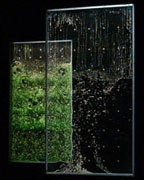May 15, 2006
[MediaRuimte]'s MR.xpo 12

Stream Space by Peter Maschke
During his residency at MediaRuimte (MR.tmp06), Peter Maschke is developing in collaboration with LAb[au] (electronics+programming), Geert Feyton from Noise Maker's Fifes (analog sound) and Frederik de Wilde (digital sound) an interactive audiovisual installation under the title Stream Space. The result of his residency will be presented in the exhibition MR.xpo 12, taking place at MediaRuimte from 25.05 - 03.06.2006. For the opening, Thursday 25.05.2006 at 22:00, Stream Space will be performed live.
Stream Space is an audiovisual installation, which takes the properties of water as its starting point. Water has always had a strong and meditative force of attraction on mankind, be it the stillness of the sea or the sound of streaming water. The installation is an attempt to translate the ever being fascination for the element water into an audio-visual concept, that invites the auditor to create his personal visual sound score.
Four acrylic glass windows measuring 210 x 110 x 2 are suspended in a space, each filled with water, dyed in a different colour. A system of air tubes arrives at the bottom of the windows and is connected to a compressor. Air can be injected, that will rise as bubbles in the water.
The idea is to capture the sound of the burbling water, to modulate it and to emphasize its quality. This will result in a specific sound-colour for each window. The project foresees a combination of passive and active elements. The passive part of the interaction, consisting of sonar boxes (or web cams), will scan the surroundings of the installation within a specific range. When a movement is captured, it will be translated into an electrical signal that will operate the valves of the air supply. In the active part, a console with four joysticks on independent circuits can be operated. Through the console, the visitor can control the amount of air injected into each of the windows, thus manipulating sound and visual contents of the installation. By this means, an interaction takes place between the visitor, the visual object and the randomised modulated tone.
PETER MASCHKE
Born in Germany, Peter Maschke has been living in Brussels since 1991. He started his career as a dancer in 1984 when, after studying dance at the London School of Contemporary Dance (UK), the Folkwang School in Essen (De), and the CNDO in Arnhem (Nl), he joins the company Plan K in Brussels. He dances in Icare and later participates in the creation of Titanic. He then participates in a series of choreographic and theatrical creations through which his interests start to be more and more directed towards set-design.
Meanwhile, he has created the sets for various dance and theatre company’s, more in particular for Rideau de Bruxelles (Les Indifférents, Prometheus), Compagnie José Besprosvany (Lara, Dos y Dos), Théâtre Le Public (L’Invisible, Belle à mourir), Pé Vermeersch (The Story of Salomé and Yokanan), Avi Kaiser (Lieber R), Juliette Bougard (The Sorry Piece), Leporello (Onkel Vania) and Compagnie Thor (l'Âme au diable).
As scenographer and/or assistant director he has collaborated with the music theatre company Tirasila, creating sets for numerous creations: Roi Ubu, K-Bel, Het Laatste Verlangen, Krsk and Slachtwerk. In 2004, he participated as assistant director in the creation of Theater Stap’s theatre piece Frankenstein, directed by Vital Schraenen.
He regularly works with the choreographer Fernando Martin's company Fuepalbar, for whom he designed sets for the choreographies Mismorigen, Ten Sueño and Mordre à travers. For these last two creations he also participated as assistant choreographer.
Currently, he is working with the artist Alexandra Dementieva on an installation, which is foreseen for Spring 2006.
LAb[au]
LAb[au], laboratory for architecture and urbanism examines possible textual, graphical and spatial forms of transcription of inFORMation processes, transmission, computation and editing through theoretic works, research / writings and production /c onception. The core of Lab[au]'s theoretical research is the impact of new information technologies on the spatial and semantic mutations through projects implicating a reflection on the perception and conception of space. The contents of Labau's work is to find a definition of architecture as a set of codes or a language drawn from concepts of communication and information sciences, by opening up the fields considered by today's architectural concept with those considered in communication and new media. Here, 'Metadesign' can be understood as a technology determinism that constitutes the main vector/thought in the concerns of networked, information-based societies with the goal to build up connectivity and effectiveness.
Posted by jo at May 15, 2006 03:28 PM
